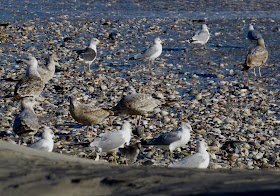I went down to Pea Island a few days after a big winter storm with high winds. We still had high winds and also had high tides, so the combination led to some coastal flooding, with sand and water on parts of Hwy 12.
I was surprised to see a cloud of gulls flying across from the Visitor Center since we usually just see single fly bys. I climbed over the little ridge of sand scraped to the side of the road, then walked through wet sand still on the road, and over a higher ridge of sand on the other side. Then I climbed through a valley in the dunes to see birds both on the shore and flying in big groups over the area where the waves broke.
When I reached the top of the dunes, I could see almost no beach. Rather the high waves broke almost at the dunes. And I saw a little basin, near the top of the dunes, that had clearly been formed by recent wave action as the waves had pushed water around the end of one of the dunes, scouring out the basin in the process. And on what beach there was, there seemed to be an entire reef of oysters torn loose by the big surf, then pushed on-shore.
 |
| A gull flies across the breaking waves |
 |
| The view just in front of the dunes- that's the base of a dune in the foreground- lesser black-backed herring, and ring-billed gulls |
 |
| Lots of oyster shells and probably some other shell species as well |
 |
| It seemed to be mostly Bonaparte's gulls that were hunting over the wayes |
 |
| A wider view of the action |
 |
| These guys could fly in very close formations |
 |
| Herring gull with crab - wish I could hire him to get some for me |
When I started home, I saw a gull in the middle of the highway with an oyster he had dropped to open it.
Across the road, it looked like business as usual, except the birds were staying out of the wind.
There were very few birds in view across from the visitor center, but I stopped at the blind, which is protected by dunes, and found lots of gadwalls, a few swans, avocets, green-winged teal, double crested cormorants and greater yellowlegs. On the way by going south, I'd also seen western sandpipers, white pelicans, and snow geese taking advantage of the lower winds where the pond is narrower and there are more islands and dunes.
 |
| Yellowlegs and gadwall were close enough to photograph from the bird blind |
 |
| On the hunt |
 |
| Avocets were scattered around in small groups, also feeding |
When this comes out, I expect to be playing, paddling, and birding with my South Carolina friend, Laurel. Looking forward to all of that.
Many of these birds will soon begin their flight to their summer homes. Hope you help keep track of migration by turning in your bird counts on a regular basis to eBird.
I'm linking to Wild Bird Wednesday. For more great bird blogs, click the picture.











No comments:
Post a Comment